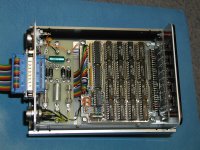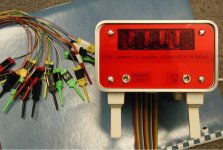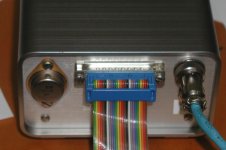... Here's with a real example of what you're stuck with if you only have TTL:
Here are the schematics for a Wang 2200 computer that sold for $7,400 in 1973 money (That's about $50,000 today) for a minimal 4K system.
(more about the Wang) This machine uses a
single 74181 on its ALU board, and all together it looks like what we'd call the "CPU" (if we were comparing it to an 8080 or something) is spread across around six boards. It was clocked at 10mhz, but took around 16 cycles to complete most "microinstructions", which weren't really comparable to the "visible" instructions on a normal CPU; many microinstructions were necessary for even the simplest operation. In other words, this baby was pretty slow despite its relatively high input clock speed, and it lived inside a giant metal suitcase cabled to a power supply about the size of a microwave oven. (the terminal was separate) Switching from "straight" TTL to LS sped the machines up significantly and get rid of the microwave oven power supply; by 1976 denser memory devices finally enabled them to offer a low end "PCS" model that fit inside of a (very fat) desktop terminal case. (Although arguably the main line remained the giant suitcases, which started incorporating systems to support multiple terminals and act like baby Minicomputers.)
Anyway, this 1976 "portable" Wang still weighed a ton and cost $5400 for an 8K computer. (FWIW, this was considered "cheap" compared to the 16K configuration of the competing IBM 5100, which was priced at a cool $8,975.) At this point you could get a microcomputer of roughly similar capabilites for around a third of that price (including a monitor ), and by the end of 1977 the Wang would be competing with $599 TRS-80s. It's hard to compare the absolute performance of the Wang machines to early microprocessor-powered PCs because the Wang computers could literally only run BASIC; it was baked into their microcodes, but for most practical purposes they were "similar", maybe for some BASIC programs the Wang could be faster than a cheap micro running a software BASIC, but you can see how this isn't even a contest at this point in terms of "bang for the buck".
(Wang themselves baked their TTL CPUs into proprietary VLSI chips by the early 80's, essentially turning them into microcomputers, to get the margins up. And by the late 80's they started selling their legacy customers a system that had a 386 CPU in it running a software version of their BASIC "microcode", because at this point they were too niche to keep developing hardware themselves..)
Anyway, you can see how there is *no way* we would have had a "home computer revolution" in the 1970's with the cheapest machines costing as much as Cadillacs. (Or even houses.) Getting the scale of integration up was the only way that was ever going to bring the price down enough for that to happen.





